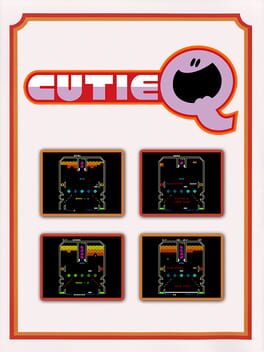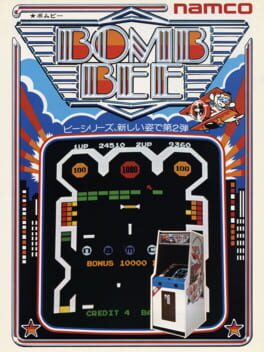

Namco's first independently designed video arcade game, Gee Bee combines gameplay elements of pinball and Breakout. There are two paddles, one at the bottom and one in the middle, that stay aligned when moving, so players must pay attention to both when bouncing the ball. There are blocks at the top, sides. and in two tiny compartments on the sides near the bottom. There is also a third, stationary, vertically-oriented paddle in the middle, as well as bumpers to give it a pinball feel. Scoring depends on what objects you hit. This was the first of three similar games designed and developed by Toru Iwatani, the creator of Pac-Man.
Also in series
Reviews View More
And we can try, to understand,
The Atari games' effect on Nam[co]
Whether you're a plumber or a cute dungeon crawler, you're indebted to Nam, you're indebted to Nam. But it's not alright—it's not even okay. And I can't look the other way. Toru Iwatani's first game shows all the growing pains & missteps you'd expect from an arcade developer dabbling in microchip games after years of electromechanical (eremeka) products. It's more than a curio, though. The beginnings of Pac-Man's cheeky fun show up even this early, if you can believe it. Just know it's not the real deal—the Hee Bee Gee Bees, if you will.
Speaking later in his career, an Iwatani then swamped with management duties asserted that "making video games is an act of kindness to others, a tangible gift of happiness." This axiom of purpose comes after his own complaints about the stagnation of '80s game centers, then flush with shoot-em-ups and less-than-innovative software. Around 1987, even Namco's own arcade output had trailed off in mechanical ambition, trading out the derring-do of Dragon Buster for the excellent but conventional Dragon Spirit. One could argue he had rose-tinted glasses this early, ignoring all the clones and production frenzy of Golden Age arcade games like his own. But he's arguing most for elegance and player-first design, something attempted with Gee Bee.
Conceived as a compromise between the pinball tables he wanted to make and Pres. Nakamura & co.'s interest in imports like Breakout, their 1978 debut had ambitions. It's an early go at combining multiple mechanics and score strategies found in Steve Wozniak's creation and post-war pinball designs. Anyone walking by the cab would see the vague, amusing outline of a human face made from barriers & breakables. Together with the requisite comical marquee & paddle, this would have seemed familiar enough to players at the time while enticing them with novelty. What's the bee chipping away at? Are we stinging our selves with delight as the blocks dissipate, our attacks moving faster and faster? That kind of imagination springs forth from even a premise as simple as this.
I'm sad to say that the mind-meld of pinball and electronic squash just wasn't feasible this early on. Gee Bee offers neither the flash and nuances of the best flipper games Chicago could offer, nor the pure and addictive game loop Wozniak wrought from Clean Sweep. Iwatani and his co-developers hamstrung themselves by refusing to commit one way or the other. There's a few too many ways to screw yourself over in Gee Bee, from less intuitive physics to the screen resetting every time you lose a ball. Inability to reach high scores is one thing, but that denial of progress is a buzzkill. All your careful threading of the needle to hit all the NAMCO letters for the multiplier can go to waste in an instant. All the patience needed to clear one upper half, thus blocking the ball from a previously open tunnel, feels like a cruel joke.
If what I'm saying gives you the heebie-jeebies, then don't overthink it. The game's recognizable to modern players, and fun for a little bit at least. But there's just no longevity here except for ardent score seekers. I can see why, for all of Namco's work to promote it, Gee Bee didn't take off at home or abroad. Space Invaders had innovated upon the destructive form of Pong that Breakout started, while this feels like an evolutionary dead-end. Bomb Bee & Cutie Q would try to salvage this with some success, of course. I'm just unsurprised that Iwatani learned from the mistakes made here, keeping that focus on levity & eclectic design in Pac-Man & Libble Rabble. On a technical level, this board still has some positives of note, mainly its fluidity & amount of color vs. the rest of the market. It's worth a try for historic value, and a sneak peek of the game development ethos Iwatani spread to other Namco notables in the coming years.
The Atari games' effect on Nam[co]
Whether you're a plumber or a cute dungeon crawler, you're indebted to Nam, you're indebted to Nam. But it's not alright—it's not even okay. And I can't look the other way. Toru Iwatani's first game shows all the growing pains & missteps you'd expect from an arcade developer dabbling in microchip games after years of electromechanical (eremeka) products. It's more than a curio, though. The beginnings of Pac-Man's cheeky fun show up even this early, if you can believe it. Just know it's not the real deal—the Hee Bee Gee Bees, if you will.
Speaking later in his career, an Iwatani then swamped with management duties asserted that "making video games is an act of kindness to others, a tangible gift of happiness." This axiom of purpose comes after his own complaints about the stagnation of '80s game centers, then flush with shoot-em-ups and less-than-innovative software. Around 1987, even Namco's own arcade output had trailed off in mechanical ambition, trading out the derring-do of Dragon Buster for the excellent but conventional Dragon Spirit. One could argue he had rose-tinted glasses this early, ignoring all the clones and production frenzy of Golden Age arcade games like his own. But he's arguing most for elegance and player-first design, something attempted with Gee Bee.
Conceived as a compromise between the pinball tables he wanted to make and Pres. Nakamura & co.'s interest in imports like Breakout, their 1978 debut had ambitions. It's an early go at combining multiple mechanics and score strategies found in Steve Wozniak's creation and post-war pinball designs. Anyone walking by the cab would see the vague, amusing outline of a human face made from barriers & breakables. Together with the requisite comical marquee & paddle, this would have seemed familiar enough to players at the time while enticing them with novelty. What's the bee chipping away at? Are we stinging our selves with delight as the blocks dissipate, our attacks moving faster and faster? That kind of imagination springs forth from even a premise as simple as this.
I'm sad to say that the mind-meld of pinball and electronic squash just wasn't feasible this early on. Gee Bee offers neither the flash and nuances of the best flipper games Chicago could offer, nor the pure and addictive game loop Wozniak wrought from Clean Sweep. Iwatani and his co-developers hamstrung themselves by refusing to commit one way or the other. There's a few too many ways to screw yourself over in Gee Bee, from less intuitive physics to the screen resetting every time you lose a ball. Inability to reach high scores is one thing, but that denial of progress is a buzzkill. All your careful threading of the needle to hit all the NAMCO letters for the multiplier can go to waste in an instant. All the patience needed to clear one upper half, thus blocking the ball from a previously open tunnel, feels like a cruel joke.
If what I'm saying gives you the heebie-jeebies, then don't overthink it. The game's recognizable to modern players, and fun for a little bit at least. But there's just no longevity here except for ardent score seekers. I can see why, for all of Namco's work to promote it, Gee Bee didn't take off at home or abroad. Space Invaders had innovated upon the destructive form of Pong that Breakout started, while this feels like an evolutionary dead-end. Bomb Bee & Cutie Q would try to salvage this with some success, of course. I'm just unsurprised that Iwatani learned from the mistakes made here, keeping that focus on levity & eclectic design in Pac-Man & Libble Rabble. On a technical level, this board still has some positives of note, mainly its fluidity & amount of color vs. the rest of the market. It's worth a try for historic value, and a sneak peek of the game development ethos Iwatani spread to other Namco notables in the coming years.
Cute, but like other games before it, it disguises as a pinball simulations and winds up being a bloated Breakout clone. Not very interesting in my opinion, and if anything it makes you realize how delicate a balance the original Breakout struck with the amount blocks that were present on the screen.
-------------------------------------------------------------------------
Es mono, pero al igual que otros juegos, se disfraza de máquina de pinball y termina siendo un clon de Breakout sobrecargado. En mi opinión no es muy interesante y, en todo caso, te hace darte cuenta del delicado equilibrio que logró el Breakout original con la cantidad de bloques que dispuso en la pantalla.
-------------------------------------------------------------------------
Es mono, pero al igual que otros juegos, se disfraza de máquina de pinball y termina siendo un clon de Breakout sobrecargado. En mi opinión no es muy interesante y, en todo caso, te hace darte cuenta del delicado equilibrio que logró el Breakout original con la cantidad de bloques que dispuso en la pantalla.


